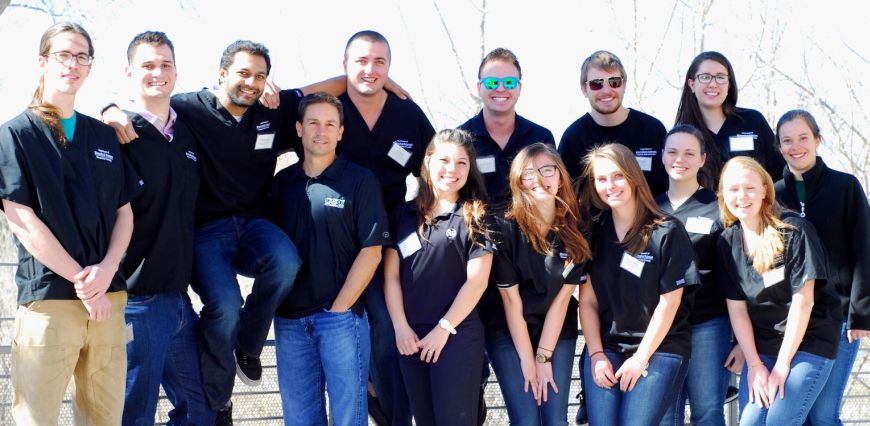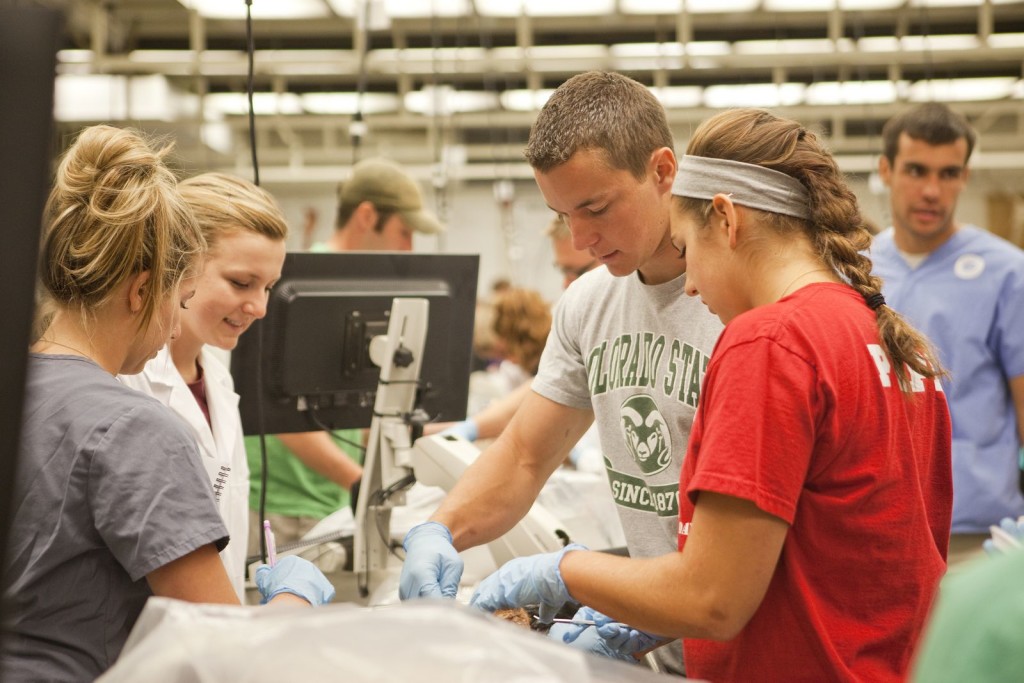
Above: CSU’s team of passionate anatomy instructors.
The human body is an amazing thing. But being able to actually hold a heart or explore the gray and white matter of a brain with your own two hands ignites a much deeper appreciation for everything the body’s anatomy makes it possible for us to do.
Colorado State University’s Department of Biomedical Sciences will introduce youth to its renowned gross anatomy lab through interactive K-12 community events in February and March, and the university’s first annual anatomy camp for high school students in July.
“Everything we do is hands-on and exciting,” said Tod Clapp, assistant professor in the Department of Biomedical Sciences and head of the popular anatomy outreach program that engages youth in science and health.
Starting Saturday, Feb. 15, students from kindergarten through college will have the opportunity to participate in a series of interactive programs including Heartbreakers, Little Shop of Physics, BRAINstorm, and Anatomy Camp 2016.
The community events, staffed by CSU faculty and student volunteers, provide a variety of learning stations that give students unique opportunities to dissect organs, participate in simulations, and actually see the difference between healthy and diseased parts of the body.
“I see things click for the students that come to these events when what they’ve learned about in science class suddenly becomes real,” said Kayla Brown, anatomy instructor in the Department of Biomedical Sciences.
Shay Schwiesow, a senior in the Department of Biomedical Sciences and an aspiring physician assistant, is a regular event volunteer and enjoys being able to share what she’s learned in college with future students. “It’s a neat way to give back and inspire young people to get excited about anatomy,” Schwiesow said. “It’s cool to know what your body does so that you can take better care of it.”
Anatomy Camp 2016
Space is limited! Sessions are July 10-16 and 24-30. For more information or to register, visit anatomycamp.colostate.edu.
Free Community Events
Students and families of all ages are welcome to attend the anatomy outreach program’s upcoming series of free, one-day interactive learning events, no registration necessary:
Heartbreakers – Saturday, Feb. 13, 10 a.m.-1 p.m. at the Fort Collins Museum of Discovery
Make like a blood cell and walk through a map of the heart’s chambers, dissect a pig heart, observe both healthy and diseased human hearts, create blood out of candy, measure your own blood pressure, and more.
Little Shop of Physics – Saturday, Feb. 27, 10 a.m.-5 p.m. at Colorado State University’s Lory Student Center Cherokee Park Room
Surround yourself with real human and animal anatomical specimens and gain a deeper understanding of the body’s inner workings, walk the path that food takes as it travels through the digestive system, build a set of lungs, and more.
BRAINstorm – Saturday, March 5, 10 a.m.-1 p.m. at the Fort Collins Museum of Discovery
Hold a human brain and be awed by its fragility and complexity, dissect a sheep’s brain, get up close and personal with the nervous system, build a neuron, learn how memory, taste, and smell work, and more.
High school students to solve real-world health case studies at CSU’s first summer anatomy camp

Anatomy Camp provides high school students with science, technology, engineering, and math (STEM) education enrichment, foundational knowledge in the field of biomedical sciences through in-depth instruction of basic human anatomy, and real-world experience that will set them apart during the competitive college application process.
“This camp is not only for students interested in pursuing pre-medical majors in college,” said Christianne Magee, assistant professor in the Department of Biomedical Sciences. “It’s for any student with an interest in learning more about general health and wellbeing.”
The weeklong camp’s comprehensive curriculum includes prosecting real anatomical specimens, dissecting animal specimens, mentoring and practice working with case studies, studying cross-sectional anatomy, building anatomical clay models, and learning Virtual Human Dissector (VHD) software.
“On the first day of camp, students will be presented with a medical case study,” said Clapp. “Their main challenge for the week is to solve the case using critical thinking and collaborative learning skills and to present their findings to the group.”
Anatomy camp students will also have the opportunity to learn from and network with clinicians and other working health care professionals, receive mentorship, and participate in leadership and team-building activities. The camp experience is rounded out with after-lab summertime activities including whitewater rafting, hiking excursions, and visits to historic Old Town Fort Collins and its Museum of Discovery.
Students leave camp with new friends, a leg up in pre-medical knowledge, and their own set of scrubs.
“Pre-medical students often don’t get this type of experience until their junior year of college,” Magee said. “Anatomy camp helps give students a head start on developing important professional skills.”